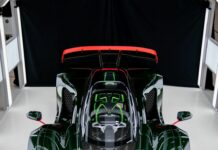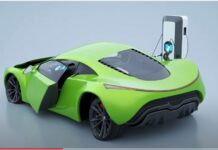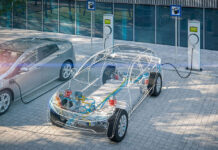The Audi e-tron GT is defined by its duality: A high-performance gran turismo that can be just as easily driven spiritedly as it can be in leisure. The Audi RS e-tron GT, the first EV from Audi Sport sold in the U.S., expands this dual personality. Key to this characteristic are its electric propulsion system, three-chamber air suspension, all-wheel steering, and two-speed transmission.
Permanent excitement
An element of performance the Audi e-tron GT shares with the world’s most thrilling roller coasters also contributes to its exhilarating performance: permanently excited magnets. Found in both the front and rear axles of the e-tron GT and RS e-tron GT, permanently excited synchronous motors (PSM) are ideal for the e-tron GT thanks to the motors’ ample, instant torque from a standstill. The e-tron GT produces 235 horsepower at its front motor and 429 horsepower at its rear motor. The motors’ net combined output is 469 horsepower, or up to 522 horsepower with overboost for 2.5 seconds with launch control, and 464 lb-ft of torque (472 lb-ft with overboost). This allows the e-tron GT to repeatedly accelerate from 0-60 mph in 3.9 seconds on the way to a top track speed of 152 mph.
The RS e-tron GT shares its front motor with the entry e-tron GT but has a more powerful rear motor, capable of producing 450 horsepower. Together, the front and rear motors in the RS e-tron GT produce a net 590 horsepower and up to 637 horsepower with overboost. Total system torque is 612 lb-ft. As a result, the RS e-tron GT can accelerate from 0-60 mph in 3.1 seconds and has a 155 mph top track speed. That places the acceleration of RS e-tron GT on par with the V10-powered Audi R8 supercar – all while generating zero direct emissions.
A unique feature in contrast to much of the Audi electric grand tourer’s competition is its two-speed transmission, providing the e-tron GT with rapid acceleration when it is needed and a taller second gear for sustained highway stretches.
*Net combined horsepower and torque ratings according to SAE calculations.
Air apparent
The Audi e-tron GT comes standard with a three-chamber air suspension. Compared with the air suspension found in the e-tron and e-tron Sportback models, the new air suspension has a 60% greater capacity, which allows its duality in performance to further shine. Through this application, a wide variation in spring rates between the softest and firmest settings is achieved, providing comfort in daily driving or nimble reflexes tuned on the rigorous Nürburgring Nordschleife racetrack.
The three-chamber air suspension enables comfortable basic suspension and can adjust the body to different heights – 22 millimeters (0.9 in) downward and 20 millimeters (0.8 in) upward. The chambers in each spring can be activated and deactivated individually to suit the driving situation, and they work closely together with the controlled dampers (standard). Both systems are managed by a central control unit, the electronic chassis platform (ECP).

Turning point
Available in e-tron GT models and standard in RS e-tron GT models, all-wheel steering provides a maximum of 2.8 degrees in the rear – in the opposite direction up to a speed of around 30 mph to increase low-speed agility, and in the same direction above approximately 30 mph to aid stability at speed.
A standard rear differential lock with fixed locking values assists during various thrust and traction scenarios. It is designed to improve traction and stability and help reduce load change reactions; minor brake and steering interventions on the wheels round off its work. The controlled rear-axle differential lock is available as an option on e-tron GT and is standard in the RS e-tron GT. The multi-plate clutch is its core element. It can be actuated variably, and the locking range extends from zero to 100%. The driver can perceive this on slippery road surfaces and during maximum full-stop braking – in this case, the lock opens up completely, allowing the Electronic Stabilization Control (ESC) to brake each wheel with great precision.
Battery and charging
All Audi e-tron GT models in the U.S. will benefit from a 93.4 kWh lithium-ion battery pack, with a unique integrated cooling structure underneath the battery pack. This draws heat away from the battery pack and allows the battery to be housed within an aluminum frame designed for structural rigidity and to protect occupants.

With an 800-volt electrical architecture, the e-tron GT comes standard with the ability to charge at an industry-benchmark 270 kW using DC fast-chargers. This allows it to replenish its battery from 5-80% in just 22.5 minutes – among the quickest charging rates currently available of any EV. Preliminary manufacturer’s estimated ranges based on approximation of EPA test cycles for a full charge are 238 miles for the e-tron GT and 232 miles for the RS e-tron GT. EPA estimates not yet available at this time.
Precision and quality
Uncompromisingly high-quality, the Audi e-tron GT and RS e-tron GT models are assembled in the Böllinger Höfe plant alongside the Audi R8 supercar. Production of the Audi e-tron GT uses 100% eco-electricity, with a combined heat and power plant fired with biogas providing the necessary heat for the Böllinger Höfe. Emissions that cannot yet be avoided are compensated with carbon credits from certified climate protection projects.
In the process of creating the latest flagship in the e-tron family, no detail was too small, from design and manufacturing to responsible materials used and even the unique acceleration sound that audio engineers created specifically for the electric performance vehicle.


















